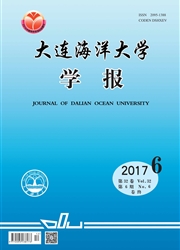

 中文摘要:
中文摘要:
为研究人工放流4龄中华鲟Acipenser sinensis对长江口盐度的可能适应性,以淡水为对照,测定了在盐度为5、10急性胁迫下,鱼体在6、12、24、48、96 h时各种血液生化指标的含量。结果表明:与对照组相比,4龄中华鲟进入盐度为5的水中后,6 h时鱼血清中谷丙转氨酶(ALT)含量显著升高(P〈0.05);12 h时,血清中血糖(GLU)、高密度脂蛋白胆固醇(HDL-C)含量显著升高(P〈0.05),而ALT含量恢复至对照组水平;24 h时,尿素(UREA)含量显著降低(P〈0.05),而GLU、HDL-C含量则恢复至对照组水平。4龄中华鲟进入盐度为10的水中后,6 h时鱼血清中总蛋白(TP)、ALT含量显著升高(P〈0.05);12 h时,血清中TP、GLU、甘油三酯(TG)、HDL-C含量显著升高(P〈0.05),而ALT含量则恢复至对照组水平;24 h时,血清中胆固醇(CHOL)、HDL-C含量显著降低(P〈0.05),而TP、GLU、TG含量则恢复至对照组水平;48、96 h时,血清中HDL-C含量显著降低(P〈0.05),而CHOL含量恢复至对照组水平。本研究表明,在4龄中华鲟盐度适应过程中,蛋白质可能优先于其他物质被动员而发挥调节作用,糖和脂肪则是机体重要的能量来源。
 英文摘要:
英文摘要:
In order to understand salinity adaptation of Chinese sturgeon Acipenser sinensis,some biochemical parameters were measured in serum of 4-years-old Chinese sturgeon exposed to freshwater(as the control) and a salinity of 5 and 10 brackish water at 6,12,24,48 h,and 96 h.The results showed that the serum alanine aminotransferase(ALT) activity was increased significantly in the fish exposed to a salinity of 5 at 6 h,compared with the control(P〈0.05),and recovered to the control level at 12 h.The glucose(GLU),and high-density lipoprotein cholesterol(HDL-C) contents were found to be significantly increased at 12 h(P〈0.05) and recovered to the control level at 24 h.However,urea(UREA) content was significantly decreased at 24 h(P〈0.05).In the fish exposed to a salinity of 10,serum total protein(TP) content and ALT activity at 6 h,TP,GLU,triglyceride(TG),and HDL-C contents at 12 h were significantly increased compared with the control(P〈0.05).Total cholesterol(CHOL) content at 24 h,and HDL-C content at 24,48 h and 96 h were shown to be significantly decreased(P〈0.05).ALT activity at 12 h,TP,GLU,and TG contents at 24 h,and CHOL content at 48 h were found to be recovered to the control levels.The findings indicate that serum protein plays a regulatory role with priority of carbohydrate and lipids which function importantly in energy supply during the adaptation to brackish water in 4-years-old Chinese sturgeon.
 同期刊论文项目
同期刊论文项目
 同项目期刊论文
同项目期刊论文
 期刊信息
期刊信息
